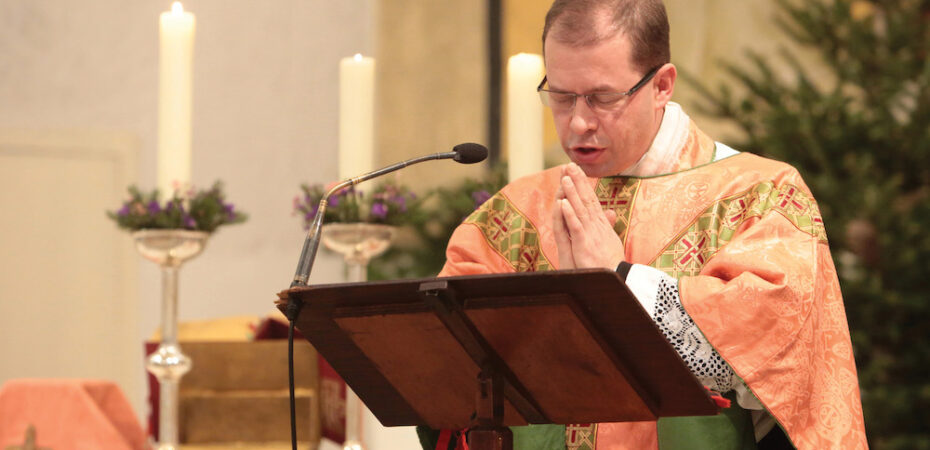7 Suggestions for a Better Homily
Know what you’re doing and know what you’re saying
Father Andrew Costello Comments Off on 7 Suggestions for a Better Homily
If you take the time to read this article, you’ll get seven suggestions for a better homily.
First: Pause Before You Preach
You’re in the pulpit. You have just read the Gospel. First suggestion: pause before you preach.
Next time you preach — try pausing — sometimes during the homily, but especially in the beginning. Feel what a pause feels like.
It might seem to be a long pause before you say that first word, but it isn’t. Pause for at least 10 seconds! Silence! Just stand there in the silence — in the pause.
Give folks a chance to get settled — to arrange kids, to check cellphones, pocketbooks, what have you. Pause. Give everyone time to get organized and have time to say inwardly, “Now what’s this homily going to be about today?”
Second: Try a Short Throwaway, but No Joke
Some preachers use a joke for icebreakers. I’m in favor of just saying, “Hello,” or “How is everyone today?”, or “Good morning.”
If they don’t answer, don’t yell back, “Hello again, everybody!”
Don’t do that. In fact, preachers who make the “I didn’t hear you” comment — when hymns are not being sung or after an opening “Hello everyone” comment — can lose the congregation in one second, even before they have begun.
Doing that, in my opinion, can trigger in folks a feeling that the preacher has just slipped into the parent role. This can make some folks inwardly and unconsciously scream, “I’m not a child.”
So simply say, “Good morning,” or “Hi!” before you preach.
We do that in conversations and when meeting and greeting others: “Hi!”
What movie had the line, “You had me at ‘hello!”? Sometimes, we lose people — or don’t connect — if we forget that simple “Hi!” first step in a conversation. The movie was “Jerry McGuire.”
Hi! What are you hoping for in reading this article?
I just gave two simple suggestions for a better homily: Pause before you begin your homily and say, “Hi” or “Hello,” but no jokes.
Third: Give Your Sermon a Title and Tell the Folks What the Title Is
The title of my homily is, “___.”
That’s how I have begun every homily I’ve given for the last 30-plus years. I don’t know where I got the idea, but I got the local reputation as the priest who gives a title to his homilies. I get kidded about it. I hope a lot of speakers do this, but I have not met another Catholic priest or deacon who does this.
I have driven by a thousand Protestant churches and often there is a sign on the front lawn with a catchy title for the preacher’s Sunday sermon.
When preparing a homily, I write a title and then start writing. Then as I move along in developing and putting together that homily — that title changes at times. Composing on the computer makes this easy to do. Then, when the writing part of the sermon is over, I revisit the title and sometimes change it based on what I have come up with in my homily. I might get cute, but that’s not my goal. I’d rather be catchy than cute.
The title is a fish hook. It’s a lure. It’s to catch minds and hearts. I want to catch and be on the thought stream of those sitting there. So, my goal is to tell the congregation what I’m going to preach in this particular homily.
Before us in church is a gathering of people on hundreds of different inner radio stations. They might be looking right at me, but naive is the preacher who thinks they are listening to me right now. I hope my title gets them to move the dial off that inner radio station they are listening to and they start listening to my sermon, the title of which is ___.
Fourth Point: Where’s the Beef?
While preparing a homily, I say a prayer, “Come, Holy Spirit!” Or “Lord, give me an insight, a light, a challenge, some food, some meat, something that will nourish these folks with this homily.”
Then, at my desk, I say out loud the three Sunday readings, pray the psalm sometimes and then read those readings a few more times. If a theme or a title or a subject hits me, I jot it down on a piece of paper as a one-liner. For example: “What Did You Catch?”; “Help! I Need Somebody” (Beatles song); “Sin and Grace Under Pressure”; “Forgiveness is a Repeat Performance”; “Listening! We Get It, But Often Forget It”; “Who Is More Me? Martha or Mary?”
Then, sometimes, if nothing hits me, I’ll say another “Come, Holy Spirit.” Then I might read another person’s homily on these three readings. Then sometimes something hits me.
If I steal a story or an idea or an image from someone, I give credit. I might say something like this: “In a homily for today, I noticed in America magazine, or The Priest magazine, or in a sermon by Bill Bausch, an intriguing example or the following story. …”
Immediately, that tells folks I did some homework for them, as well as triggering, “OK, what did you read?” “What hit you?”
……………………………………………………………………………………………………………………………………………..
The Touchstone to Meet the People
In “A Big Heart Open to God,” an article in America magazine on Sept. 19, 2013, Pope Francis said: “The homily is the touchstone to measure the pastor’s proximity and ability to meet his people, because those who preach must recognize the heart of their community and must be able to see where the desire for God is lively and ardent. The message of the Gospel, therefore, is not to be reduced to some aspects that, although relevant, on their own do not show the heart of the message of Jesus Christ.”
…………………………………………………………………………………………………………………………………………….
Where’s the beef?
At many meals, there are three parts: the appetizers, the main dish or entree, and then the dessert. When asked by the person next to us at a restaurant, “What are you going to get?”, we usually report about the main part of the meal: steak, salmon, tuna, pork chops, veal parmesan.
What’s the beef? What am I going to get? What do I want or need?
At sermon time, we are the chef. We are the cook. If we give substance — that is, if we give a challenging message, a good clear insight of Jesus or Isaiah — then we have done our job of presenting a nourishing meal to the congregation.
Notice that if the meal is great, the cook is not noticed. The meal is. The message of a good sermon is noticed and is nourishing.
The main dish is where we have to do the work, the preparation, the transubstantiation — preparing a good meal for the folks this Sunday. No fast food, no leftovers, no canned goods … People know a good steak. People know a good homily.
So the title of this fourth point is to come up with a strong clear message for the day, triggered by something in the readings.
This is the heart of the matter. This is the meal. This is the meat. This is the Good News. This is where we need to pray. This is where we need to be converted. This is where we need to put in the time. This is where we need to have a clear message.
I’ve worked for 14 years giving retreats in two different retreat houses. Three different times someone said to me: “I can tell when our pastor has made a retreat. His sermons are much better for the next four weeks, at least.”
Preparing a good homily takes work. It is like preparing a good meal.
Have you ever heard someone say, “My Aunt Mary is a great cook”? Has anyone ever said of a preacher in your parish, “Our priest [or deacon] gives us a good sermon week after week”?
“Our church serves the best food for thought in town” and “This is the best pulpit in town.” Now those are great compliments.
Fifth: Where’s the Script?
My sister-in-law once said: “I like it when the priest has a script when he is in the pulpit. It tells me he has prepared something for me.” Then she jokingly added, “So at least have a blank piece of paper in hand when you’re in the pulpit.” Therefore, I have a typed copy of my homily when I preach and I don’t try to hide it.
A priest I was stationed with never used a script. At least five times a year he would say out loud — sort of at me — that people hate it when preachers read their homilies. That has not been my experience.
When I first began preaching, I typed out my homily. Then for years after that, I would use an outline and type out what I preached afterward. Then, when I was stationed in St. Mary’s Parish, Annapolis, Maryland, from Day 1, and for the next 17 years, I had a typed copy of my homily in hand. Without knowing it, I started doing that.
Of course, if someone uses a script, they better not sound like they are just reading their homily. They need to preach their homily. They need to do a lot of practicing with their homily alone or with others if they prefer to practice that way.
A script helps me know how long my homily is going to be. A script helps us choose our words better. A script gives us a hard copy of our homily. A script helps words take flesh and appear on paper. A script can tell us if we have a solid worked-out message. And when someone asks for a copy of our homily, we can say: “Great! It’s up there in the pulpit in a green folder. It’s yours. Thank you.”
[If you’re reading this in one shot, take a break, and let my first five suggestions for a better homily sink in.]
Sixth: Framework or Formula
During our seminary years we received a lot of training in preaching. I am a lifer — having gone to a Redemptorist minor seminary for high school and then two years of college. Then we had a novitiate year followed by six years in the major seminary. In the major seminary we had the last two years of college and then four years of theology.
That’s a lot of schooling.
For 12 years, every semester, once a week, we had a class in public speaking.
That’s a lot of training.
We practiced articulation drills and voice skills. We also got up in public all through those years, giving short sermons or speeches to one other.
In this part of my article — No. 6. I want to stress part of our training was to have a sermon structure. We were taught to have a framework or method or a model in mind.
Carpenters have blueprints. They are the plan for their construction.
Jesus was a carpenter.

When we see a house, we don’t see the blueprints. We do see the finished project.
When we preach, the folks don’t see our plan or format. Hopefully, they get a message.
From time to time, I like to use the “refrain technique.” It works if it works; if it doesn’t, it can drive folks crazy.
Type into Google, “I Have a Dream Speech by Dr. Martin Luther King Jr.” Listen to it. Notice and hear his use of the refrain technique.
I have a dream that this article will help preachers.
A refrain is used at key points or in key spots in one’s homily. If the refrain is our thesis, it’s even better. If the refrain is catchy or musical with short brief words, even better. If the congregation gets it and starts to repeat it with us — like the psalm response or refrain — it’s even better. If it’s a dud, or it’s not us, we’ll find out.
So that’s one format for a homily. It’s called the “refrain technique.”
For over 10 years, I was one of a group of priests who wrote sermons for Markings — a homiletic service from the Thomas More Association in Chicago. After the title or headline, came three parts. Part 1 was an opening image or story. Part 2 was homiletic reflections. And last, Part 3 was practical applications.
All three parts needed to flow and be part of one another.
Preach long enough. Listen to enough sermons. Be analytic. We’ll know a good bit about preaching and how different preachers structure or don’t structure their stuff.
After our “Hello” or “Good Morning!” after telling folks our title, it can be a smart beginning, if we say, “I’d like to begin with a story …”
The catch can be when we move from the concrete to the abstract. That’s when things can get tricky. Or folks might think: How does this connect with the readings of the day?
When preaching, it’s easy to lose people. Sometimes we want that. We want them talking to themselves. That’s called “thinking.” We want them to get in touch with their dreams and their God. But we don’t want them to get lost in our unprepared babble.
I know of some families who, after Sunday Mass, ask in the car or at the breakfast restaurant table or when they get home, “What was the sermon about?” I have found out that folks can often repeat the opening story or example, but after that, all else can be “Muddy River.”
Then the head-scratcher conversation follows: “Wait a minute, was he saying that the woman at the well was just like the woman the preacher saw in the supermarket the other day. She had 11 items at the 10-item checkout counter and got yelled at by the lady behind her who only had three items.”
Then there is the prop sermon. I was stationed with a guy who was great with props. The prop was always hidden. He’d give a short pitch about something — then stop — and walk over to the back of the altar and come back to where he was preaching, holding a compass or a boomerang or a yo-yo or a hammer in hand.
I called that the prop sermon. Props work and not just for kids’ sermons. However, there are some warnings. Like an opening-story sermon, it better be connected to the readings and the message of the day.
Next, if we use a prop every week — we can get trapped into expectations. On the way into church on Sunday, when folks spot us, they always ask, “What’s your prop today?” In a way that could be a compliment, but it can also be a trap.
I think it’s better to vary the meals. One week use a prop. Another week, begin the sermon with a story or a movie or a song. Another week, begin with: “Today’s three readings zero in on the theme of hope. Let me give three big life issues where we need hope.”
That’s a variation of the 1, 2, 3 frameworks. It too can work.
However, here comes another warning. If folks expect a 10-minute homily and we’re taking five minutes for Point 1, and then five minutes for Point 2, when they hear “Point 3,” they might say inwardly: “Oh no! There are five more minutes to go, at least.”
In talks where I have a bunch of short points — sometimes I like to say, “I have five points,” or “I have seven points,” and then shoot through Points 2 and 4 or 3 and 5 — each in one minute or 30 seconds.
YouTube videos often use the 10 top movies or 10 biggest bloopers, and they can pull that off in 3 minutes and 23 seconds.
So my sixth message: know frameworks and use them. Check out homily books and notice the formats various preachers use.
Seventh: Conclusion
Many people love the words, “In conclusion …” in a homily — that is, if the speaker means it or only uses it once in a homily and near the end to signal the end is coming.
Looking back over 55 years of preaching, the conclusion is the weakest part of my homilies.
Martin O’Malley, the former governor of Maryland, told me that he likes to come up with an ending for a talk as the first thing he does when putting the talk together.. That hit me, but I still haven’t done it.
I notice that some preachers and speakers like to end with a quote or a short poem. I’ll add, if you do that, better make it very short.
Others like to sum up their homily in one strong sentence — or maybe even repeat their title.
David Belasco, a Broadway writer, director and producer, once said, “If you can’t write your idea on the back of my calling card, you don’t have a clear idea.”
Conclusion: Know what you’re doing, know what you’re saying, and, unlike this long article, get it done in under 10 minutes.
FATHER ANDREW COSTELLO is a Redemptorist priest who has authored five books and multiple magazine articles. He resides in New Jersey.
…………………………………………………………………………………………………………………………………………..
Pope Francis Defines a Beautiful Homily
“It is worthy remembering that ‘the liturgical proclamation of the word of God, especially in the Eucharistic assembly, is not so much a time for meditation and catechesis as a dialogue between God and his people, a dialogue in which the great deeds of salvation are proclaimed and the demands of the covenant are continually restated.’ The homily has special importance due to its eucharistic context: It surpasses all forms of catechesis as the supreme moment in the dialogue between God and his people which lead up to sacramental communion. The homily takes up once more the dialogue which the Lord has already established with his people. The preacher must know the heart of his community, in order to realize where its desire for God is alive and ardent, as well as where that dialogue, once loving, has been thwarted and is now barren.
“The homily cannot be a form of entertainment like those presented by the media, yet it does need to give life and meaning to the celebration. It is a distinctive genre, since it is preaching situated within the framework of a liturgical celebration; hence it should be brief and avoid taking on the semblance of a speech or a lecture. A preacher may be able to hold the attention of his listeners for a whole hour, but in this case his words become more important than the celebration of faith. If the homily goes on too long, it will affect two characteristic elements of the liturgical celebration: its balance and its rhythm. When preaching takes place within the context of the liturgy, it is part of the offering made to the Father and a mediation of the grace which Christ pours out during the celebration. This context demands that preaching should guide the assembly, and the preacher, to a life-changing communion with Christ in the Eucharist. This means that the words of the preacher must be measured, so that the Lord, more than his minister, will be the center of attention.”
— Evangelii Gaudium, Nos. 137-138
……………………………………………………………………………………………………………………………………………





